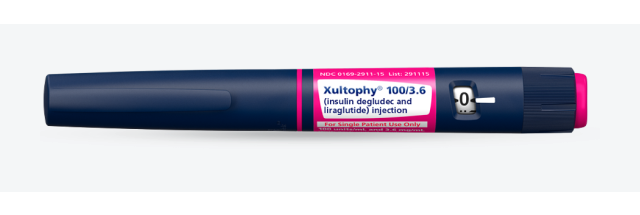Choosing a treatment for your patients with T2D? Review the safety and efficacy of Xultophy® 100/3.6.
Explore coverage options for patients who are new to Xultophy® 100/3.6, including our formulary tool and supports.
Important Safety Information for Xultophy® 100/3.6
WARNING: RISK OF THYROID C-CELL TUMORS
- Liraglutide, one of the components of Xultophy® 100/3.6, causes dose-dependent and treatment-duration-dependent thyroid C-cell tumors at clinically relevant exposures in both genders of rats and mice. It is unknown whether Xultophy® 100/3.6 causes thyroid C-cell tumors, including medullary thyroid carcinoma (MTC), in humans, as the human relevance of liraglutide-induced rodent thyroid C-cell tumors has not been determined.
- Xultophy® 100/3.6 is contraindicated in patients with a personal or family history of MTC and in patients with Multiple Endocrine Neoplasia syndrome type 2 (MEN 2). Counsel patients regarding the potential risk for MTC with the use of Xultophy® 100/3.6 and inform them of symptoms of thyroid tumors (e.g. a mass in the neck, dysphagia, dyspnea, persistent hoarseness). Routine monitoring of serum calcitonin or using thyroid ultrasound is of uncertain value for early detection of MTC in patients treated with Xultophy® 100/3.6.
CONTRAINDICATIONS
- Xultophy® 100/3.6 is contraindicated in patients with a personal or family history of medullary thyroid carcinoma (MTC) or in patients with Multiple Endocrine Neoplasia syndrome type 2 (MEN 2), during episodes of hypoglycemia, and in patients with hypersensitivity to Xultophy® 100/3.6, either of the active substances, or any of its excipients. Serious hypersensitivity reactions including anaphylactic reactions and angioedema have been reported with liraglutide, one of the components of Xultophy® 100/3.6.
WARNINGS AND PRECAUTIONS
- Risk of Thyroid C-cell Tumors: If serum calcitonin is measured and found to be elevated or thyroid nodules are noted on physical examination or neck imaging, the patient should be further evaluated.
- Acute Pancreatitis: Acute pancreatitis, including fatal and non-fatal hemorrhagic or necrotizing pancreatitis, has been observed in patients treated with GLP-1 receptor agonists, including liraglutide, one of the components of Xultophy® 100/3.6 . Observe patients carefully for signs and symptoms of pancreatitis (persistent severe abdominal pain, sometimes radiating to the back with or without vomiting). If pancreatitis is suspected, discontinue Xultophy® 100/3.6 and initiate appropriate management.
- Never Share a Xultophy® 100/3.6 Pen Between Patients, even if the needle is changed. Sharing of the pen poses a risk for transmission of blood-borne pathogens.
- Hyperglycemia or Hypoglycemia with Changes in Insulin Regimen: Changes in an insulin regimen (e.g., insulin strength, manufacturer, type, or injection site or method of administration) may affect glycemic control and predispose to hypoglycemia or hyperglycemia. Repeated insulin injections into areas of lipodystrophy or localized cutaneous amyloidosis have been reported to result in hyperglycemia; and a sudden change in the injection site (to an unaffected area) has been reported to result in hypoglycemia. Make any changes to a patient’s insulin regimen under close medical supervision with increased frequency of blood glucose monitoring. Advise patients who have repeatedly injected into areas of lipodystrophy or localized cutaneous amyloidosis to change the injection site to unaffected areas and closely monitor for hypoglycemia. Adjustments in concomitant anti-diabetic treatment may be needed.
- Overdose Due to Medication Errors: Instruct patients to check the label before each injection since accidental mix-ups with insulin containing products can occur. Do not administer more than 50 units of Xultophy® 100/3.6 daily. Do not exceed the 1.8 mg maximum recommended dose of liraglutide or use with other GLP-1 RAs.
- Hypoglycemia: Hypoglycemia is the most common adverse reaction of insulin-containing products, including Xultophy® 100/3.6. Severe hypoglycemia can cause seizures, may be life threatening or cause death. Hypoglycemia can impair concentration ability and reaction time which may place the patient and others at risk in situations where these abilities are important. Hypoglycemia can happen suddenly and symptoms may differ in each patient and change over time in the same patient. Symptomatic awareness of hypoglycemia may be less pronounced in patients with longstanding diabetes, diabetic neuropathy, and in patients using drugs that block the sympathetic nervous system, or who experience recurrent hypoglycemia. The long-acting effect of insulin degludec may delay recovery from hypoglycemia compared to shorter acting insulins. Increase monitoring with changes to: dose, co-administered glucose lowering medications, concomitant drugs, meal pattern, physical activity; and in patients with hypoglycemia unawareness or renal or hepatic impairment.
- Acute Kidney Injury Due to Volume Depletion: There have been postmarketing reports of acute kidney injury, in some cases requiring hemodialysis, in patients treated with liraglutide, one of the components of Xultophy® 100/3.6. The majority of reported events were nausea, vomiting or diarrhea leading to dehydration. Monitor renal function in patients reporting gastrointestinal adverse reactions that could lead to volume depletion especially during initiation and escalation.
- Severe Gastrointestinal Adverse Reactions: Use of GLP-1 receptor agonists, including liraglutide, one of the components of Xultophy® 100/3.6, has been associated with gastrointestinal adverse reactions, sometimes severe. In a Xultophy® 100/3.6 clinical trial severe gastrointestinal adverse reactions were reported among patients receiving Xultophy® 100/3.6 (0.8 %) and patients receiving the active comparators liraglutide (2.9%) and insulin degludec (0.2%). Xultophy® 100/3.6 is not recommended in patients with severe gastroparesis.
- Hypersensitivity and Allergic Reactions: Severe, life-threatening, generalized allergy, including anaphylaxis, angioedema, bronchospasm, hypotension, and shock can occur with insulins, including Xultophy® 100/3.6. There have been postmarketing reports of serious hypersensitivity reactions (e.g. anaphylactic reactions and angioedema) in patients treated with liraglutide, one of the components of Xultophy® 100/3.6. If a hypersensitivity reaction occurs, discontinue and treat promptly per standard of care, and monitor until signs and symptoms resolve. Anaphylaxis and angioedema have been reported with other GLP-1 RAs. Use caution in a patient with a history of anaphylaxis or angioedema with other GLP-1 RAs because it is unknown whether such patients will be predisposed to these reactions with Xultophy® 100/3.6.
- Acute Gallbladder Disease: Acute events of gallbladder disease such as cholelithiasis or cholecystitis have been reported in GLP-1 receptor agonist trials and postmarketing. In a cardiovascular outcomes trial (LEADER trial) 3.1% of patients treated with liraglutide, one of the components of Xultophy® 100/3.6, versus 1.9% of placebo treated patients reported an acute event of gallbladder disease, such as cholelithiasis or cholecystitis. If cholelithiasis is suspected, gallbladder studies and appropriate clinical follow-up are indicated.
- Hypokalemia: All insulin containing products, including Xultophy® 100/3.6 can lead to life-threatening hypokalemia, which may then cause respiratory paralysis, ventricular arrhythmia, and death. Monitor potassium levels in patients at risk for hypokalemia and treat if indicated.
- Fluid Retention and Congestive Heart Failure: Patients using insulin containing products, including Xultophy® 100/3.6, with thiazolidinediones (TZDs) should be observed for signs and symptoms of heart failure. If heart failure develops, dosage reduction or discontinuation of the TZD must be considered.
- Pulmonary Aspiration During General Anesthesia or Deep Sedation: Xultophy® 100/3.6 delays gastric emptying. There have been rare postmarketing reports of pulmonary aspiration in patients receiving GLP-1 receptor agonists undergoing elective surgeries or procedures requiring general anesthesia or deep sedation who had residual gastric contents despite reported adherence to preoperative fasting recommendations. Instruct patients to inform healthcare providers prior to any planned surgeries or procedures if they are taking Xultophy® 100/3.6.
ADVERSE REACTIONS
- The most common adverse reactions, reported in ≥5% of patients treated with Xultophy® 100/3.6 are nasopharyngitis, headache, nausea, diarrhea, increased lipase and upper respiratory tract infection.
DRUG INTERACTIONS
- Certain drugs may affect glucose metabolism, requiring dose adjustment and close monitoring of blood glucose. The signs and symptoms of hypoglycemia may be reduced or absent in patients taking anti-adrenergic drugs (e.g., beta-blockers, clonidine, guanethidine, and reserpine).
- Liraglutide-containing products, including Xultophy® 100/3.6, cause a delay of gastric emptying, and thereby have the potential to impact the absorption of concomitantly administered oral medications. Caution should be exercised when oral medications are concomitantly administered with liraglutide-containing products.
USE IN SPECIFIC POPULATIONS
- Xultophy® 100/3.6 should be used during pregnancy only if the potential benefit justifies the potential risk to the fetus.
Please click here for Xultophy® 100/3.6 Prescribing Information, including Boxed Warning.
Indications and Limitations of Use
Xultophy® 100/3.6 (insulin degludec and liraglutide) injection 100 units/mL and 3.6 mg/mL is a combination of insulin degludec and liraglutide and is indicated as an adjunct to diet and exercise to improve glycemic control in adults with type 2 diabetes mellitus.
- Xultophy® 100/3.6 is not recommended as first-line therapy for patients who have inadequate glycemic control on diet and exercise.
- Xultophy® 100/3.6 is not recommended for use in combination with any other product containing liraglutide or another GLP-1 receptor agonist (GLP-1 RA).
- Xultophy® 100/3.6 is not recommended for the treatment of diabetic ketoacidosis.
- Xultophy® 100/3.6 has not been studied in combination with prandial insulin.
Important Safety Information for Xultophy® 100/3.6
WARNING: RISK OF THYROID C-CELL TUMORS
- Liraglutide, one of the components of Xultophy® 100/3.6, causes dose-dependent and treatment-duration-dependent thyroid C-cell tumors at clinically relevant exposures in both genders of rats and mice. It is unknown whether Xultophy® 100/3.6 causes thyroid C-cell tumors, including medullary thyroid carcinoma (MTC), in humans, as the human relevance of liraglutide-induced rodent thyroid C-cell tumors has not been determined.
- Xultophy® 100/3.6 is contraindicated in patients with a personal or family history of MTC and in patients with Multiple Endocrine Neoplasia syndrome type 2 (MEN 2). Counsel patients regarding the potential risk for MTC with the use of Xultophy® 100/3.6 and inform them of symptoms of thyroid tumors (e.g. a mass in the neck, dysphagia, dyspnea, persistent hoarseness). Routine monitoring of serum calcitonin or using thyroid ultrasound is of uncertain value for early detection of MTC in patients treated with Xultophy® 100/3.6.
Important Safety Information for Xultophy® 100/3.6
WARNING: RISK OF THYROID C-CELL TUMORS
- Liraglutide, one of the components of Xultophy® 100/3.6, causes dose-dependent and treatment-duration-dependent thyroid C-cell tumors at clinically relevant exposures in both genders of rats and mice. It is unknown whether Xultophy® 100/3.6 causes thyroid C-cell tumors, including medullary thyroid carcinoma (MTC), in humans, as the human relevance of liraglutide-induced rodent thyroid C-cell tumors has not been determined.
- Xultophy® 100/3.6 is contraindicated in patients with a personal or family history of MTC and in patients with Multiple Endocrine Neoplasia syndrome type 2 (MEN 2). Counsel patients regarding the potential risk for MTC with the use of Xultophy® 100/3.6 and inform them of symptoms of thyroid tumors (e.g. a mass in the neck, dysphagia, dyspnea, persistent hoarseness). Routine monitoring of serum calcitonin or using thyroid ultrasound is of uncertain value for early detection of MTC in patients treated with Xultophy® 100/3.6.
CONTRAINDICATIONS
- Xultophy® 100/3.6 is contraindicated in patients with a personal or family history of medullary thyroid carcinoma (MTC) or in patients with Multiple Endocrine Neoplasia syndrome type 2 (MEN 2), during episodes of hypoglycemia, and in patients with hypersensitivity to Xultophy® 100/3.6, either of the active substances, or any of its excipients. Serious hypersensitivity reactions including anaphylactic reactions and angioedema have been reported with liraglutide, one of the components of Xultophy® 100/3.6.
WARNINGS AND PRECAUTIONS
- Risk of Thyroid C-cell Tumors: If serum calcitonin is measured and found to be elevated or thyroid nodules are noted on physical examination or neck imaging, the patient should be further evaluated.
- Acute Pancreatitis: Acute pancreatitis, including fatal and non-fatal hemorrhagic or necrotizing pancreatitis, has been observed in patients treated with GLP-1 receptor agonists, including liraglutide, one of the components of Xultophy® 100/3.6 . Observe patients carefully for signs and symptoms of pancreatitis (persistent severe abdominal pain, sometimes radiating to the back with or without vomiting). If pancreatitis is suspected, discontinue Xultophy® 100/3.6 and initiate appropriate management.
- Never Share a Xultophy® 100/3.6 Pen Between Patients, even if the needle is changed. Sharing of the pen poses a risk for transmission of blood-borne pathogens.
- Hyperglycemia or Hypoglycemia with Changes in Insulin Regimen: Changes in an insulin regimen (e.g., insulin strength, manufacturer, type, or injection site or method of administration) may affect glycemic control and predispose to hypoglycemia or hyperglycemia. Repeated insulin injections into areas of lipodystrophy or localized cutaneous amyloidosis have been reported to result in hyperglycemia; and a sudden change in the injection site (to an unaffected area) has been reported to result in hypoglycemia. Make any changes to a patient’s insulin regimen under close medical supervision with increased frequency of blood glucose monitoring. Advise patients who have repeatedly injected into areas of lipodystrophy or localized cutaneous amyloidosis to change the injection site to unaffected areas and closely monitor for hypoglycemia. Adjustments in concomitant anti-diabetic treatment may be needed.
- Overdose Due to Medication Errors: Instruct patients to check the label before each injection since accidental mix-ups with insulin containing products can occur. Do not administer more than 50 units of Xultophy® 100/3.6 daily. Do not exceed the 1.8 mg maximum recommended dose of liraglutide or use with other GLP-1 RAs.
- Hypoglycemia: Hypoglycemia is the most common adverse reaction of insulin-containing products, including Xultophy® 100/3.6. Severe hypoglycemia can cause seizures, may be life threatening or cause death. Hypoglycemia can impair concentration ability and reaction time which may place the patient and others at risk in situations where these abilities are important. Hypoglycemia can happen suddenly and symptoms may differ in each patient and change over time in the same patient. Symptomatic awareness of hypoglycemia may be less pronounced in patients with longstanding diabetes, diabetic neuropathy, and in patients using drugs that block the sympathetic nervous system, or who experience recurrent hypoglycemia. The long-acting effect of insulin degludec may delay recovery from hypoglycemia compared to shorter acting insulins. Increase monitoring with changes to: dose, co-administered glucose lowering medications, concomitant drugs, meal pattern, physical activity; and in patients with hypoglycemia unawareness or renal or hepatic impairment.
- Acute Kidney Injury Due to Volume Depletion: There have been postmarketing reports of acute kidney injury, in some cases requiring hemodialysis, in patients treated with liraglutide, one of the components of Xultophy® 100/3.6. The majority of reported events were nausea, vomiting or diarrhea leading to dehydration. Monitor renal function in patients reporting gastrointestinal adverse reactions that could lead to volume depletion especially during initiation and escalation.
- Severe Gastrointestinal Adverse Reactions: Use of GLP-1 receptor agonists, including liraglutide, one of the components of Xultophy® 100/3.6, has been associated with gastrointestinal adverse reactions, sometimes severe. In a Xultophy® 100/3.6 clinical trial severe gastrointestinal adverse reactions were reported among patients receiving Xultophy® 100/3.6 (0.8 %) and patients receiving the active comparators liraglutide (2.9%) and insulin degludec (0.2%). Xultophy® 100/3.6 is not recommended in patients with severe gastroparesis.
- Hypersensitivity and Allergic Reactions: Severe, life-threatening, generalized allergy, including anaphylaxis, angioedema, bronchospasm, hypotension, and shock can occur with insulins, including Xultophy® 100/3.6. There have been postmarketing reports of serious hypersensitivity reactions (e.g. anaphylactic reactions and angioedema) in patients treated with liraglutide, one of the components of Xultophy® 100/3.6. If a hypersensitivity reaction occurs, discontinue and treat promptly per standard of care, and monitor until signs and symptoms resolve. Anaphylaxis and angioedema have been reported with other GLP-1 RAs. Use caution in a patient with a history of anaphylaxis or angioedema with other GLP-1 RAs because it is unknown whether such patients will be predisposed to these reactions with Xultophy® 100/3.6.
- Acute Gallbladder Disease: Acute events of gallbladder disease such as cholelithiasis or cholecystitis have been reported in GLP-1 receptor agonist trials and postmarketing. In a cardiovascular outcomes trial (LEADER trial) 3.1% of patients treated with liraglutide, one of the components of Xultophy® 100/3.6, versus 1.9% of placebo treated patients reported an acute event of gallbladder disease, such as cholelithiasis or cholecystitis. If cholelithiasis is suspected, gallbladder studies and appropriate clinical follow-up are indicated.
- Hypokalemia: All insulin containing products, including Xultophy® 100/3.6 can lead to life-threatening hypokalemia, which may then cause respiratory paralysis, ventricular arrhythmia, and death. Monitor potassium levels in patients at risk for hypokalemia and treat if indicated.
- Fluid Retention and Congestive Heart Failure: Patients using insulin containing products, including Xultophy® 100/3.6, with thiazolidinediones (TZDs) should be observed for signs and symptoms of heart failure. If heart failure develops, dosage reduction or discontinuation of the TZD must be considered.
- Pulmonary Aspiration During General Anesthesia or Deep Sedation: Xultophy® 100/3.6 delays gastric emptying. There have been rare postmarketing reports of pulmonary aspiration in patients receiving GLP-1 receptor agonists undergoing elective surgeries or procedures requiring general anesthesia or deep sedation who had residual gastric contents despite reported adherence to preoperative fasting recommendations. Instruct patients to inform healthcare providers prior to any planned surgeries or procedures if they are taking Xultophy® 100/3.6.
ADVERSE REACTIONS
- The most common adverse reactions, reported in ≥5% of patients treated with Xultophy® 100/3.6 are nasopharyngitis, headache, nausea, diarrhea, increased lipase and upper respiratory tract infection.
DRUG INTERACTIONS
- Certain drugs may affect glucose metabolism, requiring dose adjustment and close monitoring of blood glucose. The signs and symptoms of hypoglycemia may be reduced or absent in patients taking anti-adrenergic drugs (e.g., beta-blockers, clonidine, guanethidine, and reserpine).
- Liraglutide-containing products, including Xultophy® 100/3.6, cause a delay of gastric emptying, and thereby have the potential to impact the absorption of concomitantly administered oral medications. Caution should be exercised when oral medications are concomitantly administered with liraglutide-containing products.
USE IN SPECIFIC POPULATIONS
- Xultophy® 100/3.6 should be used during pregnancy only if the potential benefit justifies the potential risk to the fetus.
Please click here for Xultophy® 100/3.6 Prescribing Information, including Boxed Warning.
Indications and Limitations of Use
Xultophy® 100/3.6 (insulin degludec and liraglutide) injection 100 units/mL and 3.6 mg/mL is a combination of insulin degludec and liraglutide and is indicated as an adjunct to diet and exercise to improve glycemic control in adults with type 2 diabetes mellitus.
- Xultophy® 100/3.6 is not recommended as first-line therapy for patients who have inadequate glycemic control on diet and exercise.
- Xultophy® 100/3.6 is not recommended for use in combination with any other product containing liraglutide or another GLP-1 receptor agonist (GLP-1 RA).
- Xultophy® 100/3.6 is not recommended for the treatment of diabetic ketoacidosis.
- Xultophy® 100/3.6 has not been studied in combination with prandial insulin.
References:
- Xultophy 100/3.6 [package insert]. Plainsboro, NJ: Novo Nordisk Inc.
- Lingvay I, Pérez Manghi F, García-Hernández P, et al; DUAL V Investigators. Effect of insulin glargine up-titration vs insulin degludec/liraglutide on glycated hemoglobin levels in patients with uncontrolled type 2 diabetes: the DUAL V randomized clinical trial. JAMA. 2016;315(suppl 1):898-907.









